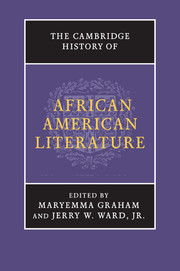Book contents
- Frontmatter
- Introduction
- PART I AFRICAN AMERICAN LITERATURE FROM ITS ORIGINS TO THE TWENTIETH CENTURY
- 1 Sounds of a tradition: the souls of black folk
- 2 Early print literature of Africans in America
- 3 The emergence of an African American literary canon, 1760–1820
- 4 Dividing a nation, uniting a people: African American literature and the abolitionist movement
- 5 African American literature and the abolitionist movement, 1845 to the Civil War
- 6 Writing freedom: race, religion, and revolution, 1820–1840
- 7 “We wish to Plead our own Cause”: independent antebellum African American literature, 1840–1865
- 8 Racial ideologies in theory and practice: political and cultural nationalism, 1865–1910
- 9 The “fictions” of race
- 10 “We Wear the Mask”: the making of a poet
- 11 Toward a modernist poetics
- PART II AFRICAN AMERICAN LITERATURE IN THE TWENTIETH CENTURY
- PART III AFRICAN AMERICAN LITERATURE AS ACADEMIC AND CULTURAL CAPITAL
- Bibliography
- Index
- References
9 - The “fictions” of race
from PART I - AFRICAN AMERICAN LITERATURE FROM ITS ORIGINS TO THE TWENTIETH CENTURY
Published online by Cambridge University Press: 28 May 2011
- Frontmatter
- Introduction
- PART I AFRICAN AMERICAN LITERATURE FROM ITS ORIGINS TO THE TWENTIETH CENTURY
- 1 Sounds of a tradition: the souls of black folk
- 2 Early print literature of Africans in America
- 3 The emergence of an African American literary canon, 1760–1820
- 4 Dividing a nation, uniting a people: African American literature and the abolitionist movement
- 5 African American literature and the abolitionist movement, 1845 to the Civil War
- 6 Writing freedom: race, religion, and revolution, 1820–1840
- 7 “We wish to Plead our own Cause”: independent antebellum African American literature, 1840–1865
- 8 Racial ideologies in theory and practice: political and cultural nationalism, 1865–1910
- 9 The “fictions” of race
- 10 “We Wear the Mask”: the making of a poet
- 11 Toward a modernist poetics
- PART II AFRICAN AMERICAN LITERATURE IN THE TWENTIETH CENTURY
- PART III AFRICAN AMERICAN LITERATURE AS ACADEMIC AND CULTURAL CAPITAL
- Bibliography
- Index
- References
Summary
In order to understand the literary production of the period between the American Civil War and the First World War, readers need to be aware of the complex set of narratives that shaped the era. By “narratives,” we mean the stories created to explain national and regional history, institutions, beliefs, and social practices. It is through such stories that national, regional, racial, and gender identities are constructed and justified. Thus, the white South, after the Civil War, reinvented its rebellion and defeat as a tragedy in which a noble cause was overwhelmed by the region's own pride and by massive Northern aggression. This narrative was embodied in “plantation school” fiction by Thomas Nelson Page and others. The Union narrative was divided into separate plots; this division enabled the triumph of white supremacy later in the nineteenth century. On the one hand, the North saw itself as attempting to maintain the nation that had been established by the Founding Fathers in the face of Southern assault on that vision. The alternative story represented the war as expansion of the national principles of liberty and justice through the abolition of slavery. In this version, the helpless and needy black population was saved through the courageous actions of Northern white soldiers and politicians against the greedy and lecherous plantation owners. The immediate aftermath of the war was an effort to bring together the Southern story with the first Northern one, as Andrew Johnson largely agreed to allow the South to reenter the Union without fundamental change beyond the constitutional end of slavery.
- Type
- Chapter
- Information
- The Cambridge History of African American Literature , pp. 177 - 205Publisher: Cambridge University PressPrint publication year: 2011
References
- 2
- Cited by

